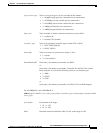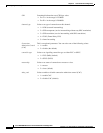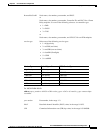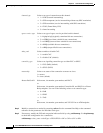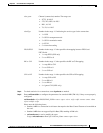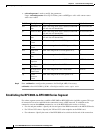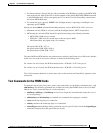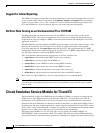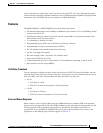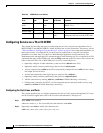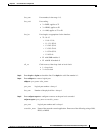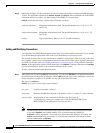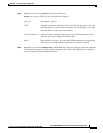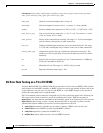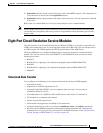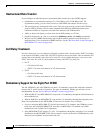
6-45
Cisco MGX 8850 Multiservice Switch Installation and Configuration
Release 1.1.31, Part Number 78-11223-03 Rev. B0, May 2005
Chapter 6 Card and Service Configuration
Circuit Emulation Service Module for T3 and E3
logical connection (as a data pipe) on the line and runs at the full T3 or E3 rate. Although the typical
connection setup is the three-segment connection across an ATM network, the CESM can support a DAX
connection. Up to 26 CESM card sets can operate in an MGX 8850 shelf.
Features
The MGX-CESM-T3 or MGX-CESM-E3 provide the following features
• Unstructured data transfer at 44.736 Mbps (1189980 cells per second) for T3 or 34.368 Mbps (91405
cells per second) for E3
• Synchronous timing by either a local clock sourced on the PXM1 or loop timing (transmit clock
derived from receive clock on the line)
• 1:1 redundancy is through a Y-cable
• Programmable egress buffer size (in the form of cell delay variation)
• Programmable cell delay variation tolerance (CDVT)
• Per VC queuing for the transmit and receive directions
• An idle code suppression option
• Bit count integrity when a lost AAL1 cell condition arises
• Alarm state definitions per G.704
• Trunk conditioning by way of framed AIS for T3 and unframed, alternating 1s and 0s for E3
• On-board bit error rate testing (BERT)
Cell Delay Treatment
You can configure a tolerable variation in the cell arrival time (CDVT) for the receive buffer. After an
underrun, the receiver places the contents of the first cell to arrive in a receive buffer then plays it out at
least one CDVT value later. The maximum cell delay and CDVT (or jitter) are:
• For T3
–
Cell delay of 4 msec
–
CDVT of 1.5 msec in increments of 125 microseconds
• For E3
–
Cell delay of 2.9 msec
–
CDVT of 2 msec in increments of 125 microseconds
Error and Alarm Response
When it detects a loss of signal (LOS) alarm, the CESM notifies the connected CPE in the upstream
direction after an integration period. The CESM continues to emit cells at the nominal rate but sets the
ATM cell payload with an appropriate data pattern as specified by the ATM Forum CES V2.0
specification. Also, an OAM cell with RDI code goes to the far end to indicate out-of-service. The
significance of the different types of alarms appears in Table 6-4.



